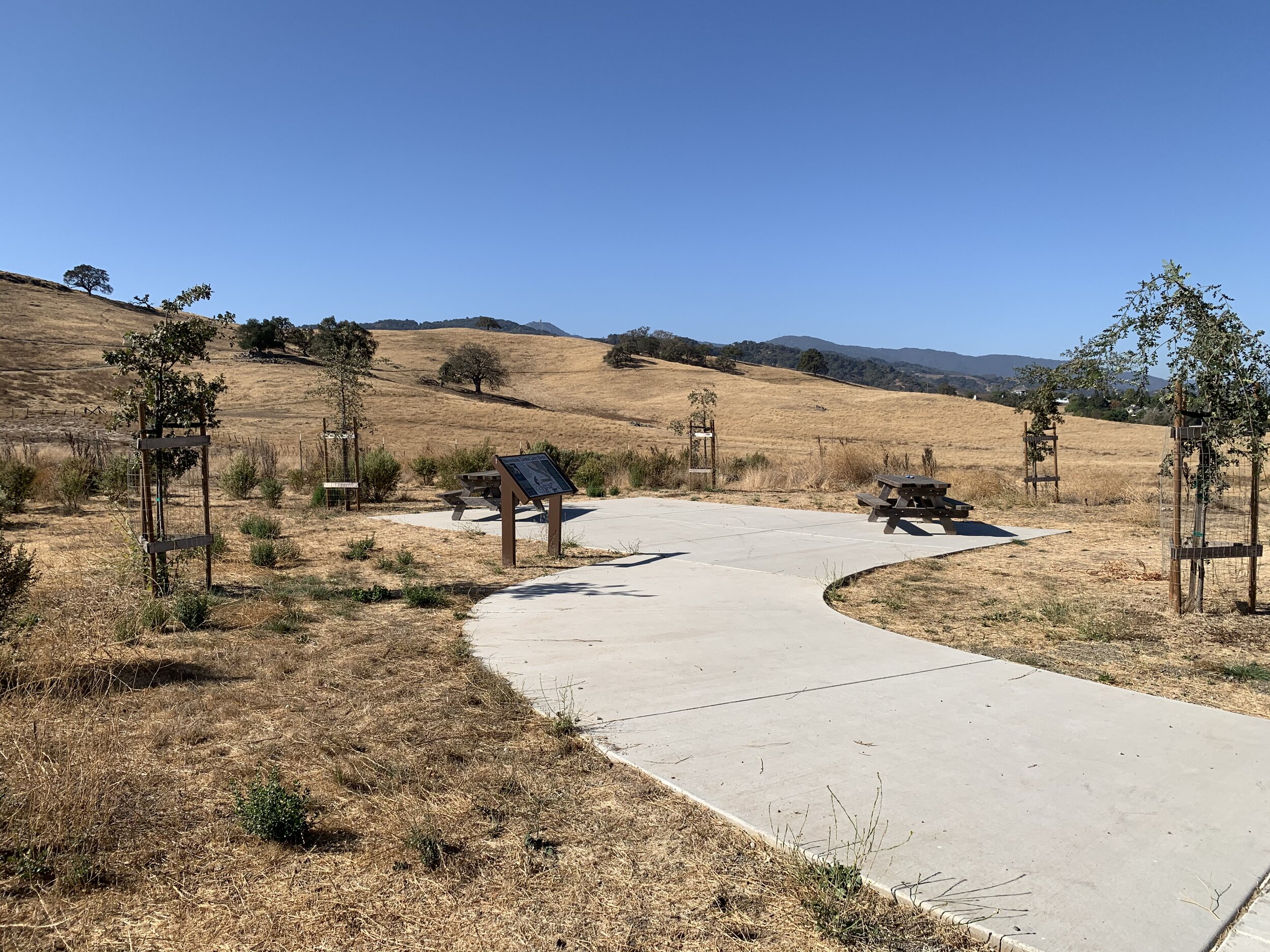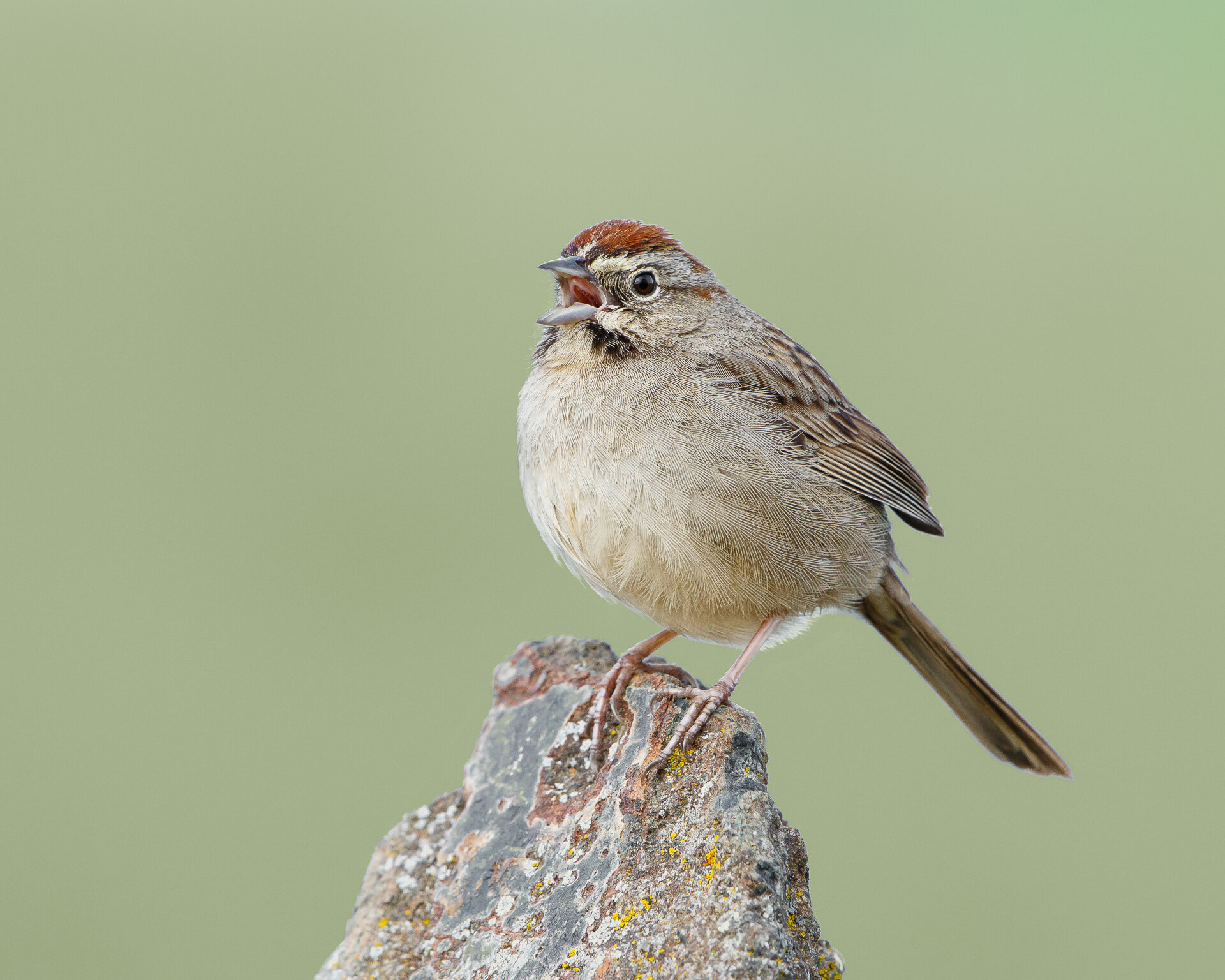Rancho San Vicente (Fall/Winter):
Rockin’ the Rock Wren
by Eve Meier
This fall and winter, visit the grassy hillsides of the Rancho San Vicente entrance to Calero County Park in San José. Enjoy the wide open skies and beautiful views while looking for raptors and Rock Wrens.
Trip Covers: October - February
Key Birds: Golden Eagle, Prairie Falcon (uncommon), Rock Wren, Lark Sparrow, Rufous-crowned Sparrow
How to Bird
Rancho San Vicente is an entrance to Calero County Park that opened to the public in 2018. With beautiful views, wide open skies, and interesting birds such as Rock Wren, Lark Sparrow and Golden Eagle, this location quickly became one of my favorite places.
Golden Eagle by Carter Gasiorowski
This is a two mile out-and-back trip along the gently ascending Lisa Killough Trail. This is cattle country so you will need to pass through several cattle gates and watch your footing. Also, be sure to stay off the well marked rancher’s road and close all cattle gates after passing through them.
Start your birding from the parking lot (#1 on interactive map). Often, Lark Sparrows perch on the small trees near the picnic tables. Savannah Sparrows are plentiful but often hide low in the grasses. Listen for the Western Meadowlarks calling from the meadow and scan the tree tops and raptor perches in the meadow for American Kestrel.
Two picnic tables next to the parking lot of the Rancho San Vicente entrance to Calero County Park. I often pause here to scan the hillsides for raptors. On occasion, a Prairie Falcon will be sitting on the tops of the oaks in the distance. Photo by Eve Meier
Now start on the trail by passing through the first cattle gate next to the bathroom. Ascend the gently sloped switchback up the hill, watching for more meadow-loving birds such as Say’s Phoebes or Western Bluebirds. Just after passing through the 2nd cattle gate, pause at the trough of water. Sometimes birds such as Brewer’s Blackbirds or Brown-headed Cowbirds congregate here. Part way up the hill, turn left at the trail intersection to stay on the Lisa Killough Trail (#2 on the interactive map) and head further into the hills.
Second cattle gate along the Lisa Killough Trail.
Golden Eagles are often perched on the power towers that are now in front of you. Turkey Vultures are more often seen circling in the thermals. If you hear the ground squirrels yipping their alarm call, scan for a Prairie Falcon or Golden Eagle on the hunt.
Do you know how to distinguish between a Turkey Vulture and a Golden Eagle in flight? Now is the time to practice. It is easy to mistake a Golden Eagle for a Turkey Vulture at a distance but one clue is that a Golden Eagle has a very stable flight while the Turkey Vulture’s flight is "tippy". That's because the vulture is stabilizing in the breezes with their wings and the eagle does it with its tail.
Golden Eagles have a steady flight and their wing shape is rectangular. Photo by Brooke Miller
Turkey Vultures hold their wings slightly raised, making a ‘V’ when seen head-on and they have a teetering flight. Photo by Brooke Miller
Make the next left to stay on the Lisa Killough Trail. As you pass through the 3rd cattle gate (#3 on map), a small, often dry canal will be on your left. On your right and just a short way up this portion of the trail will be a blackberry bush and a small seep (#4 on map). This is where I often find Lark Sparrow. Sometimes they can be deeply hidden in the dense bush, other times they may be sitting right on top. Get to know their tinkling call and the flash of the white on the outside edges of their tails as they fly away.
Blackberry bush and small seep loved by Lark Sparrow and other birds along the Lisa Killough Trail. Photo by Eve Meier
Lark Sparrow by Barry Langdon-Lassagne
At the third trail intersection (5 on map), turn right to continue on the Lisa Killough Trail. Pause at the small, fenced-in wetland (6 on map) on your left to look for birds such as Lincoln's, Golden-crowned or White-crowned Sparrows hiding in the shrubs. (To learn more about the crowned sparrows, including identification tips, read SCVAS’s article on these birds.)
Small wetland along the Lisa Killough Trail. Photo by Eve Meier
California's state rock, Serpentinite. Photo by Steve Finney.
Continue along the trail noting the serpentine rocks (California’s state rock) that are protruding from the grassland on either side of you. These rocks make perfect habitat for Rock Wren. I usually hear the wren first then find them bobbing up and down on the tops of the low rocks.
Rock Wren by Peter Hart
Lisa Killough Trail through rock-strewn grassy hillside. This is the best place for Rock Wren and Rufous-crowned Sparrow.
Also check the low rocks and small shrubs for Rufous-crowned Sparrow. I usually see them along this stretch of the trail on top of the rocks or in a small shrub. Listen for their “deer, deer, deer” calls. And, continue to keep your eyes open for raptors such as American Kestrel, Cooper’s Hawk, Sharp-shinned Hawk, White-tailed Kite and Northern Harrier.
Rufous-crowned Sparrow by Steve Zamek
I usually turn around sometime along this section of the trail (7 on interactive map) but if you wish to explore further there’s a bench up ahead (8 on interactive map) where you can pause and enjoy the views of New Almaden and Casa Grande, the home to the Quicksilver Mining Museum. Higher in the hills, if you know where to look, you can also see the cypress trees of Hidalgo Cemetery in Almaden Quicksilver County Park.
Ready for More? Before heading home, stop by Calero Reservoir (9 on interactive map), only another 2 miles south on McKean Rd. Rest your feet and bird right from the parking lot. There are picnic tables and benches overlooking the water on either side of the boat launch ramp. This location is good for Bald Eagle, wintering waterfowl and more. A scope may be helpful. Entry fees may apply.
Interactive Map
Directions:
From US-101, exit Bailey Ave. Follow Bailey Ave for 3 miles to McKean Rd. Turn right onto McKean Rd. Park entrance will be on your left in about 3 miles.
From CA-85 in San Jose, exit Almaden Expy south. Drive south for about 5 miles, turn right onto Harry Rd, take the next left onto McKean Rd and go 1.3 miles. The park entrance will be on your right. Latitude/Longitude: 37.194443, -121.807667
Parking: Large paved lot
Fees: None
Public Transportation: None
Park Hours: The park is open year-round from 8 a.m. until sunset.
Facilities: ADA bathrooms, drinking water, 2 picnic tables at trailhead, 2 ADA compliant parking spots
Trip Mileage: 2 miles round trip but you can turn around anytime
Trail Conditions: gravel trail with 300 ft elevation gain, busy with mountain bikes on the weekends, full sun exposure, sections of the trail can become slippery when muddy. This is cattle country and you may come across cattle on the trail. Be sure to close all cattle gates.
Accessibility: Although this trip is not wheelchair friendly due to rough trails, the picnic tables in the parking lot area make a nice spot to bird. Bring a scope and scan the hillsides for Prairie Falcon, American Kestrel, White-tailed Kite, Golden Eagle, Western Meadowlark, Savannah Sparrow, Lark Sparrow and more.
Bikes: These trails are popular with mountain bikes but I do not recommend birding on bike for this location.
Dogs Allowed: Dogs on leash are allowed.
More Information
Calero County Park trail map
Calero County Park website
eBird hotspot Calero CP--Rancho San Vicente
All About Birds: Turkey Vulture, Golden Eagle, Rock Wren
More Resources
For more trips like this one, visit Self-guided Field Trips.
Visit the SCVAS Birding Resources page for more information on where to bird, our birding community, birding identification resources, and more.
Read “What to Look for Now” by SCVAS Executive Director Matthew Dodder.
Banner Photo Credit: Rock Wren by Peter Hart
Last Updated: 4/19/2022
Enjoyed this Trip?
Support the work of Santa Clara Valley Audubon Society and become a member. To contact the trip writer with comments, questions or location updates, please email fieldtrips@scvas.org. You can also post in the comment section below. (If you’d like to post anonymously, type your comment, select “Post Comment”, then simply provide a name, like “Guest”, and select “Comment as Guest”.)













